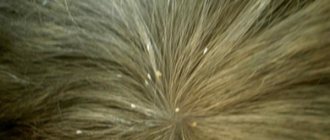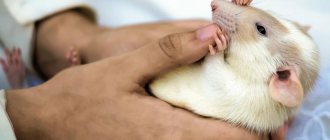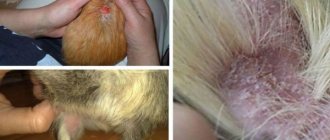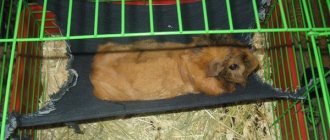Guinea pigs have a strong place among pets. These are sweet, beautiful creatures, devoid of aggression towards family members. Now there are more than one and a half dozen breeds of guinea pigs and selection work continues. Can lice-eaters appear and why in a guinea pig if it lives in a house? We will analyze everything in order in the article, including the solution to this unpleasant issue.
Like all animals, these little ones are susceptible to a number of diseases. But the veterinarians of the Ya-VET Emergency Veterinary Care Center successfully cope with all ailments. If your pig suddenly becomes lethargic
or she shows other signs of the disease, then there is no need to waste time. When treating any disease, the main thing is to start on time.
Contact the Ya-VET Center for Emergency Veterinary Care for Animals, where veterinarians with extensive experience and deep knowledge will successfully conduct research using modern equipment and, having made an accurate diagnosis, prescribe the most effective treatment.
You can call a veterinarian at home by calling. The maximum waiting time is no more than 40 minutes!
Today we propose to understand the question - what are lice eaters in guinea pigs?
, how dangerous this parasite is and what methods of combating it exist today.
Existence and reproduction of lice eaters
The parasite has a flat body. The maximum size of an adult is 2 mm. On dark pig fur it appears white or yellowish, on white fur it appears grey.
When magnifying the lice eater under a microscope, it was discovered that its fur was covered with bristles. The head is large, angular in shape, with eyes, antennae and a rather large mouth. The lice eater's jaws are powerful and covered with teeth. It moves on 6 paws with claws at the end, which additionally causes irritation on the skin of the affected animal.
Static louse multiply quite quickly. The lice beetle can lay more than 100 eggs at a time. The parasite glues them to the fur with a sebaceous substance that it secretes from its gland. The larva grows within 3 weeks.
Worms
Due to the fact that the main property of this group of parasites is to absorb nutrients from the animal’s blood, this can lead to exhaustion. Typically, guinea pigs are inhabited by tape and round parasites. Worm larvae of this type are dangerous not only for the animal, but also for the owner. With severe infection, you can see not only worm larvae in the stool, but also quite adult individuals with the naked eye. The animal is characterized by lethargic behavior, drowsiness and decreased appetite. If the infection is very strong, parasites crawling out of the anus can also be seen with the naked eye.
If the infection is not severe, you can give the animal a suspension of prazicide for kittens. The amount is calculated at the rate of 1 gram per 1 kg of animal weight. Dirofen paste has a good reputation among veterinarians. When treating an animal with medications, you need to treat the cage and accessories with a chlorine-containing solution.
Signs of parasites
Symptoms in an animal do not appear immediately, but then they are expressed in several forms:
- Itching on the skin. The pig begins to constantly itch and bite itself, trying to gnaw out the lice-eaters, without regulating the strength of the bites on the skin. As a result, wounds and abrasions appear.
- Lack of sleep and appetite. The animal becomes restless and stops eating food in normal quantities. As a result, vitamin deficiency and anemia appear, and immunity decreases.
- Hair loss.
- The animal has a sloppy appearance - the fur does not shine and looks greasy.
- The presence of parasites on the fur. When examining the fur closely, worms 1 mm long are visible.
- The tired appearance of an animal at any time of the day, as the constant struggle exhausts him emotionally.
- An allergic reaction is redness of the skin.
Important! Lice eaters are parasites that carry dangerous diseases such as helminthiasis, fungus, viruses and bacteria.
Group of ectoparasites
This type includes skin types of parasites. The most common are skin lice, fleas and lice. The first symptoms of a pet infection include redness and itching of the skin, as well as hair loss in areas where microorganisms accumulate. It is this type of parasite that causes diseases that cause exhaustion, purulent ulcers, and in advanced cases, death. Moreover, the latter scenario can occur not only due to the animal’s lack of appetite, but also due to less obvious signs such as general blood poisoning. The fact is that toxic substances enter the blood through abrasions and microcracks formed by scratching the affected areas by the animal itself.
Reasons for appearance
Static lice are transmitted through direct animal contact. Parasites also settle in sawdust and hay, which are added to the cage when cleaning. They may also appear in food packaging that has not been hermetically sealed.
The maximum risk of infection occurs during the cold season (late autumn and winter), when the animal’s fur becomes thicker and the undercoat grows more actively.
To prevent infection, you need to clean the cage more often and use proven bedding materials.
Lice
Despite the rarer occurrence of this type of parasite, they can occur even with good care of the pet. And, most dangerously, it can be transmitted to humans through contact with a sick animal. Lice cause the appearance of pediculosis, which is characterized by severe itching, obesity and increased temperature of the animal. Lice can be treated using fairly gentle methods: if the infestation is not so local, you can use specialized shampoos. Veterinarians recommend treating the animal with a 10-day course of ivarmectin just in case. The pig's cage must be washed with a solution containing chlorine. It is also necessary to shampoo all pets that have previously come into contact with the infected person.
Infection with lice beetles in humans
Experts' opinions on this matter are divided. Some scientists, as a result of research, have found that the parasite can settle on any hair surface of animals and humans.
When parasites appear, a person experiences irritation, itching, and bald areas of the scalp appear. Treatment method: anti-lice medications.
Other scientists are confident that the owner of the pig cannot become infected for the following reasons:
- Insufficient hair thickness.
- Body temperature is too low. To exist and reproduce, lice eaters need a body temperature, like that of animals, not lower than 37.4-39.3.
- If it gets on the skin, the parasite will bite, but will not be able to live long and will die after 7 days, leaving no offspring. However, an infected animal should not come into contact with children and the elderly. Their immunity is weak and interaction can lead to dermatitis.
Fleas
Oddly enough, cat-type fleas are the most common in guinea pigs. These types of parasites can get onto an animal from anywhere, even from the owner’s skin. The symptoms of the disease are similar to the previous version: redness of the skin, itching, hair loss in the affected areas. Detecting fleas is not difficult: just comb your pet's fur thoroughly.
After thoroughly brushing your pet, it is important to check for insects between the teeth of the comb or comb. Fleas settle in the external environment (bedding, upholstered furniture, carpets); in animals they can only be detected during blood feeding. Guinea pigs become infected with these parasites from sick animals, most often dogs and cats.
The process of treating fleas itself is not so complicated, but the difficulty is that in addition to treating and monitoring the health of the sick animal, it is also necessary to monitor its environment, especially if there are small animals in the offspring. Treating the animal with topical shampoos and sprays is permissible; it is important that it contains pyrethritol. They also need to wash the cage and all accessible areas. In a couple of days of high-quality treatment of the animal, you can exterminate all pests along with their larvae.
Methods of treatment and prevention of diseases
Today, means of treatment and protection against lice eaters are presented in a wide range. For ease of use, they are available in several forms:
- spray;
- drops;
- emulsion;
- shampoo;
- powder;
- collar.
Sprays are prepared based on biocidal elements. The simplest method of application is to spray the skin of the pig and spread it over the hair using massaging movements. At the initial stage of the disease, one application is sufficient. The drugs Blokhnet, Dana, Bars, and Inspector have proven themselves well.
The drops have the same base as sprays and are designed to get rid of ticks and lice. It is enough to apply a few drops on the spine in the area of the animal’s withers, where it cannot reach. Today, the effectiveness of this form is recognized as the simplest and most effective, because it provides a long-term preventive effect.
Emulsions are diluted with water or injection solution, since they are produced in concentrated form. The solution is used to treat wool. Recommended: Stop Itching, Atop 7+.
Shampoo is the safest way. A properly selected shampoo can prevent the appearance of lice by creating a protective barrier on the animal's fur. A sick animal cannot be cured by washing it with shampoo the first time. Use Phytoelite, Dana, Frontline and Bars. Their action, consistency and consumption are identical.
Collars quickly get rid of lice and protect your pet for a long time. The disadvantage of this form is a possible allergy of the pig to the components, which will be expressed in the form of skin irritation.
The powder is very fine and has a powder-like consistency. Advantages: relief from itching and irritation of the skin in a short period of time. It is enough to rub it into the skin once to maintain the effect for 1.5 weeks.
After treating the animal, you need to treat its cage or enclosure, as well as all the objects it uses. This is done with a solution of special preparations.
Rules for caring for a pig
When cleaning the cage and bathing the animal, periodically wipe toys and care products with a special solution:
- combs;
- bowls;
- the bottom and walls of the habitat;
- hairpins
Do not give your pig objects that have been used by other animals.
Conduct a visual inspection of the animal constantly, at least once a week.
Under no circumstances should you place untested animals in the cage, which could become carriers of parasites. When buying a new pet, do not immediately put it in a cage with a “keeper”, but after pre-treating it, keep it in quarantine for 7 days.
Insignificant savings and failure to comply with basic hygiene will entail large costs for the treatment and suffering of the animal. Simple rules will make the animal happy and healthy.
Try to change your pet's living conditions and diet. His house should be free and clean. Remember to regularly clean your pet's cage. Even the most comfortable house gets boring over time, so you need to periodically let the animal out to walk around the room and play with it.
Guinea pigs do not like sharp and loud sounds, so it is better to place their home in a quiet corner. There should always be food, useful elements and clean water inside. Make sure that water can flow from the waterer before placing it in the cage.
If a pet is infected with parasites, then this ultimately leads to sad consequences. If you notice that the animal is itching and is acting restless, then you need to start treating it immediately. Treatment is carried out under the supervision of a veterinarian. Remember that by providing your pet with favorable living conditions, you reduce the risk of parasite infection.
Carrying out diagnostics
You can identify fleas yourself. They can be seen with the naked eye on the rodent's face and stomach. If you comb the fur with a single-row, fine-toothed comb, it will leave behind insect excrement in the form of small brown clumps, as well as dead or living insects. Parasites are easier to detect on animals with light fur.
If the diagnosis is carried out by a veterinarian, he takes a scraping from the rodent's skin for examination.
A pig can have several diseases at the same time, for example:
- allergic dermatosis;
- ectoparasites;
- streptococcal infection;
- neurodermatitis;
- mycoses.
Any of these factors, as well as metabolic disorders and poor nutrition, cause itching, sore skin and hair loss.
To determine the presence of the disease, a scraping is taken from the animal's skin.
What not to treat
| A drug | Indications. Treatment regimen | Notes |
| Drops Lawyer | From endo- and exoparasites, including worms and different types of ticks. Dose - 0.1 ml/1 kg. Take the required amount from the tube with a syringe, remove the needle and drop it onto the skin. Hold the animal in your arms for 10-15 minutes to prevent it from scratching the area where the medicine was applied. Repeat after 14 days | Do not drip onto scratched areas of the skin. |
| Drops of Stronghold | If this is a 6% solution, then calculate the dosage, taking into account that it is 0.1 ml for 1 kg. If 12%, then 0.05 ml | |
| Otodectin injections | 0.2 ml/1 kg. The injection is made in the withers area under the skin. Repeat the procedure after 10 days | If the animal is severely affected, a 4-fold injection is possible |
The results of treatment appear gradually. Full recovery occurs after 3-4 weeks, when all adult ticks and laid larvae are destroyed or immunity is restored so much that the eggs have no opportunity to develop.
Important! Only one drug can be used. The combination threatens intoxication
A repeated cycle of digging and injections is needed in order to destroy those mites that hatched from the deposited larvae. 14 days is their ripening period. The drugs do not affect the larvae because they are protected by the shell.
Choose a remedy for lice for your guinea pig based on reviews or a recommendation from a veterinarian. The following drugs should not be used:
- Ethnomazan;
- Stomazan;
- Butox.
They are well advertised but are used exclusively for the cage and its contents. They can easily harm the animal and even lead to death.
Use only proven methods for treating your guinea pig. Keep it clean and try to prevent the appearance of lice or other parasites.
Infectious pathologies
Plague
A particularly dangerous viral disease of guinea pigs, characterized by high contagiousness and lethality. After infection, the incubation period usually does not exceed 3 weeks. Clinical signs:
- general weakness;
- convulsions;
- apathy;
- lack of coordination;
- paralysis of the hind limbs.
The diagnosis is confirmed by laboratory testing, and the sick pig is immediately euthanized. No treatment has been developed.
Pseudotuberculosis
A common pathology with high mortality and the main symptom is diarrhea. The disease has nothing in common with real tuberculosis - the name is given due to the discovery of nodules in organs during autopsy, reminiscent of tuberculous tubercles. The main difference from true tuberculosis is the absence of lung damage.
Clinical manifestations:
- watery stool mixed with mucus and blood;
- loss of appetite;
- conjunctivitis is often observed;
- palpation reveals an enlargement of the mesenteric lymph nodes;
- in the terminal stage, convulsions are observed.
A test with pseudotuberculin is used as a laboratory diagnosis, but at the moment this option is available in a small number of clinics.
Treatment is also difficult - most often pseudotuberculosis in guinea pigs occurs in a fulminant and acute form. Therapy is reduced to the administration of antibiotics (tetracycline) in a loading dose, as well as the use of sulfonamides.
Paratyphoid
For treatment use:
- tetracycline antibiotics;
- sulfadimezine;
- antityphoid serum.
Improvements in content are also being monitored. Due to diarrhea in a guinea pig, you should clean the cage more often, provide the animal with easily digestible food, and do not limit drinking.
Pasteurellosis
A bacterial disease of guinea pigs and other animals, the pathology is also dangerous for humans. In pets it manifests itself as a respiratory infection:
- profuse catarrhal-purulent discharge from the nasal passages;
- guinea pigs sneeze and rub their nose;
- hard breath;
- wheezing sounds.
With complications, diarrhea, pustular and erythematous skin lesions develop. In the terminal stage, convulsions are observed. The disease is characterized by high mortality, especially among young animals.
On large guinea pig farms, any stock showing obvious clinical signs should be separated immediately. It is recommended to destroy animals in serious condition and dead. All livestock, including clinically healthy ones, are prescribed a course of antibiotics and sulfa drugs. Therapeutic and quarantine measures are lifted a week after the last case of clinical manifestation of the disease, and all premises and equipment are disinfected.
Lymphocytic choriomeningitis
A viral disease of guinea pigs, characterized by high mortality. The infection spreads with mice; other animals can also pose a danger, so before adding a new pig to an existing one, a month-long quarantine should be carried out.
Pets experience high fever and general weakness. The diagnosis is confirmed by laboratory tests, in which case the guinea pig should be euthanized. No treatment has been developed, and the virus is also dangerous for people.
Bordetellosis
Previously, the disease was registered exclusively in dogs as “kennel cough”; later cases of infection in cats, farm animals, and rodents, including guinea pigs, were identified. The wide range of susceptible animals makes the disease dangerous for pets. In guinea pigs it often appears after contact with other animals. Therefore, the main preventive measure is to prevent contact and timely therapy, vaccination and diagnosis of dogs, cats and other animals. Vaccine prevention of bordetellosis has also been developed in guinea pigs, but it shows little effectiveness and only reduces the severity of the pathology.
Pets experience characteristic changes in the respiratory system:
- sneezing;
- labored breathing;
- catarrhal-purulent discharge from the nasal passages;
- temperature increase;
- inflammation of the conjunctiva;
- the head is often turned to one side - otitis media develops;
- appetite is reduced or absent;
- general lethargy.
Treatment is complex; the best results are achieved with the combined use of antibiotics and sulfonamide drugs:
- subcutaneous injections of baytril, intramuscular injections of gentamicin;
- sulfadimethoxine.
Specific therapy in the form of menthol inhalations and eucalyptus decoctions is difficult, so sodium bicarbonate in an amount of 0.1-0.2 g/kg, thermopsis or pectusin should be added to the feed. To support the heart, injections of sulfocamphocaine or caffeine, carboxylase are prescribed. Complex vitamin supplements are recommended.
Types of lice
Oddly enough, the varieties of lice in pigs are quite numerous. In practice, in almost 99% of cases, only two types are found, and another one is diagnosed much less frequently:
- Typically, “pigs” are parasitized by two types of lice: Gliricola porcelli and Gyropus ovalis.
- In extremely rare cases, parasites of the species Trimenopon hispidium can be found on the body of an animal.
The most characteristic species is that of G. Porcelli. Their body color is closer to yellowish, and therefore they are quite easy to spot. These parasites are quite long and when moving they noticeably “squirm”. As a rule, they are found in the form of clusters in the eye sockets and around the hair roots.
G. Ovalis are more compact in shape (as their name suggests), but in all other respects they are very similar to the previous variety.
Trimenopon hispidium, then this type of lice is extremely small and most often they are simply not noticed. However, in cases of severe infestations, you can see large accumulations of these parasites, vaguely reminiscent of tiny spiders.
Infections
Guinea pigs can become infected with fungal, viral, and bacterial infections, such as:
- Plague is a dangerous disease of viral etiology. It is highly contagious and often ends in the death of the rodent. Once initiated, the latency period in most animals is typically a maximum of 21 days. After which symptoms of the disease are observed. The animal becomes lethargic, indifferent to what is happening. He may experience seizures, problems with coordination, and paralysis of his hind legs. Unfortunately, there is no cure for this disease and, if the diagnosis is confirmed, the infected scree is euthanized.
- Pseudotuberculosis is an infectious disease of a bacterial nature that is often diagnosed in guinea pigs. Infection is possible through contaminated food.
The infection often results in the death of the pet, as it occurs in a lightning-fast form
Therefore, it is important to know the symptoms of the disease in order to begin treatment in a timely manner. The main symptom of infection is stomach upset. Mucus and blood can be found in the stool. In addition, the owner may notice loss of appetite in the animal, inflammation of the conjunctiva, enlargement of the mesenteric lymph nodes, and convulsions.
What to do when it appears? It is necessary to show the rodent to a veterinarian as soon as possible. If the diagnosis is confirmed, then antibiotics and sulfonamides are prescribed. Tetracycline can be prescribed for treatment in loading dosage.
Paratyphoid fever is an intestinal infection caused by bacteria and accompanied by signs of gastrointestinal damage, such as persistent diarrhea and bloating. The pig's stool is greenish and has an unpleasant odor. The animal refuses to eat, moves little, and is disheveled. If infection is confirmed, tetracycline and sulfadimizine are prescribed, and anti-typhoid serum is administered. In addition, to reduce the likelihood of re-infection, you should clean up after the rodent more often. Your pet's diet should consist of foods that are quickly digestible. The animal must have constant access to water. Pasteurellosis is a bacterial zoonotic disease that is dangerous to humans. If a guinea pig is sick, it will experience symptoms of respiratory damage: purulent nasal discharge, sneezing, shortness of breath, wheezing. As the infection progresses, indigestion, pustules, redness of the skin, and convulsions occur. The disease often causes the death of a rodent. Young individuals die especially often. If the infection is severe, the animal is destroyed. Treat a sick rodent with antibiotics. When pets have multiple antibiotics, antibiotic therapy is prescribed for all pets, regardless of whether they have symptoms of infection or not. Medicines are given within 7 days from the moment the disease is detected
It is also important to disinfect the room where the rodent is kept. Lymphocytic choriomeningitis is a dangerous viral disease not only for the animal, but also for its owners, which usually ends in the death of the pet. An infected individual exhibits elevated temperature and asthenia. The disease is incurable, so the infected individual is destroyed. Bordetellosis is a disease that affects not only guinea pigs, but also cats, dogs and other rodents. The main measure to prevent infection is vaccination of cats and dogs.
There is also a vaccination against bordetellosis for guinea pigs, but, unfortunately, it is ineffective and only alleviates the course of the disease.
An infected pig may sneeze and have difficulty breathing. She may have a fever, nasal discharge, conjunctivitis, ear inflammation, loss of appetite, and impotence. Often, with such an infection, the pet's head is turned to the side. When a disease is detected, the pet must be treated comprehensively; the animal is prescribed antibiotics and sulfonamides.
Prescribe either Baytril (s.c.) at a dose of 5 mg per kg of body weight for 5 days or gentamicin (i.m.) at a dose of 4-5 mg per kg of body weight. In addition, sulfadimethoxine (25 mg/kg) or sulfatone (15 mg/kg) is given with food. The course of therapy is 5 days. Expectorants are also prescribed and added to the food. You can give your animal cough tablets with thermopsis or pectusin. To normalize breathing, prescribe sulfocamphocaine or caffeine in ampoules. Atropine is prescribed to relieve spasms. For a speedy recovery, it is recommended to give the animal multivitamins.
Preventive actions
To prevent infection with ectoparasites, pigs need proper care and maintenance, the nature and characteristics of which are as follows:
- periodic examination of all pets;
- treating all items they use with insecticides;
- disinfection of feed purchased in bulk (it is kept in the freezer for 1 day);
- maintaining personal hygiene before interacting with a rodent.
Pets that are taken for walks should wear tick collars in the spring and summer. During this period, parasites are especially active. Some of them are carriers of the meningoencephalitis virus, which is dangerous for animals and people.
If your pig develops itching and anxiety, it is best to contact a veterinarian or rodentologist (a specialist in small exotic mammals) and undergo treatment under medical supervision.
Ticks
There are two types of mites on guinea pigs - subcutaneous and scabies. Each has characteristic features both in manifestation and in treatment.
The difference between this type of mites lies in the fact that they can cause severe itching of the animal’s skin. The danger for the animal lies in the fact that not only the blood will be infected, but the animal may also die due to stress. The main symptoms of subcutaneous mite infestation include the following:
- skin itching;
- severe hair loss;
- redness and dryness of the skin;
- high temperature, chills;
- refusal to eat completely or partially.
Primary lesions in guinea pigs include the head, back, sides and shoulders. But if you do not pay attention to the problem in time, they can spread throughout the animal’s body, causing even more discomfort. It’s even worse if a pregnant female is infected with parasites. In this case, there is a risk of miscarriages and complications during pregnancy.
Fur type mite
The difference from the previous species is that it settles, as a rule, on the surface of the skin. Symptoms of infection with the disease in an animal are similar to previous species. Only peeling of the skin is also observed. Refusal of water and restlessness of the animal are typical symptoms of a tick. If the infection is severe, painful ulcers may appear on the skin, and fur will begin to fall out at an increased rate.











